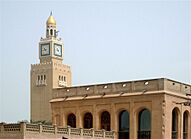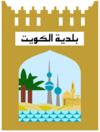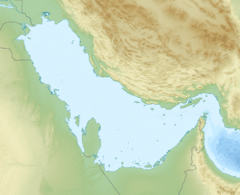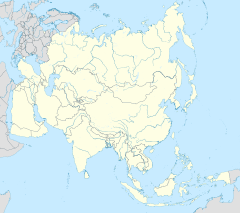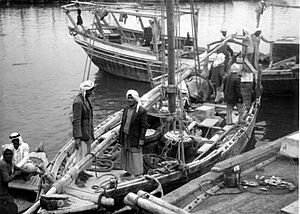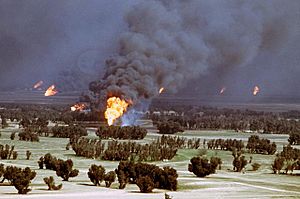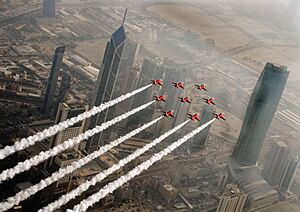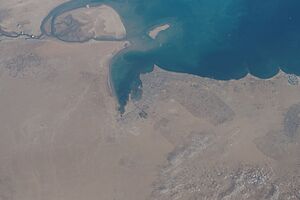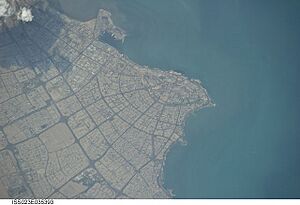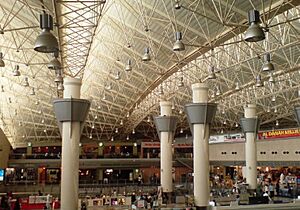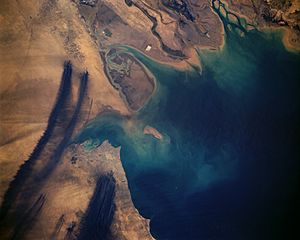Kuwait City facts for kids
Quick facts for kids
Kuwait City
مدينة الكويت
Madinat Al-Kuwayt
|
|||
|---|---|---|---|
|
From top left: Kuwait City skyline, Al Hamra Tower, Kuwait Towers, Seif Palace, Souq Sharq port Kuwait Downtown in 2012 Kuwait City Souq Sharq Marina
|
|||
|
|||
| Nickname(s):
الديرة Ad-Dirah
|
|||
| Country | |||
| Governorate | Capital | ||
| Established | 1752 | ||
| Area | |||
| • Capital city | 860 km2 (330 sq mi) | ||
| Population
(2018)
|
|||
| • Metro | 2,990,000 | ||
| • Metro density | 3,500/km2 (9,000/sq mi) | ||
| Time zone | UTC+03:00 (AST) | ||
Kuwait City (Arabic: مدينة الكويت) is the capital and largest city of Kuwait. It is located in the middle of the country, on the southern shore of Kuwait Bay along the Arabian Gulf. This city is the main political, cultural, and economic hub of Kuwait. It is home to important government buildings like Seif Palace and the main offices of many Kuwaiti companies and banks.
As of 2018, the wider area around Kuwait City had about three million people. This is more than 70% of all the people living in Kuwait! The city itself doesn't have its own separate government. Instead, parts of all six governorates of the country make up the big city area. In a simpler way, "Kuwait City" can also mean just the old, historic part of the town. This old part is now part of the Capital Governorate and blends right into the newer city areas.
Kuwait City handles its trade and travel needs through Kuwait International Airport. It also uses two important ports: Mina Al-Shuwaik (Shuwaik Port) and Mina Al Ahmadi (Ahmadi Port).
Contents
History of Kuwait City
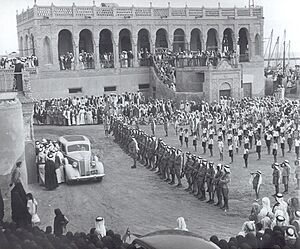
In the early to mid-1700s, Kuwait City was just a small fishing village. Around the mid-1700s, a group of people called the Bani Utubs settled there. At that time, only a few fishermen lived in Kuwait.
Becoming a Trade Center
During the 18th century, Kuwait slowly grew into a major trading center. It was a key stop for goods traveling between India, Muscat, Baghdad, Persia, and Arabia. By the late 1700s, Kuwait was already a well-known trade route from the Persian Gulf to Aleppo.
When the Persians attacked Basra (a city in Iraq) between 1775 and 1779, many Iraqi merchants came to Kuwait for safety. This helped Kuwait's boat-building and trading activities grow a lot. Because of this, Kuwait's sea trade became very successful. From 1775 to 1779, trade routes from India to Baghdad, Aleppo, Smyrna, and Constantinople were moved to Kuwait. The East India Company also started using Kuwait in 1792. This company made sure the sea routes between Kuwait, India, and East Africa were safe. Even after the Persians left Basra in 1779, Kuwait kept attracting trade away from Basra.
Kuwait was the main place for Boat building in the Persian Gulf area. In the late 1700s and 1800s, ships made in Kuwait carried most of the goods traded between ports in India, East Africa, and the Red Sea. Kuwaiti ships were famous all over the Indian Ocean. Problems in the region helped Kuwait's economy grow in the late 18th century. Kuwait became rich because Basra was unstable. Many merchants from Basra came to Kuwait to escape troubles with the government. People said that Kuwaitis were the best sailors in the Persian Gulf.
During the rule of Mubarak Al-Sabah, Kuwait was called the "Marseilles of the Gulf." This was because its strong economy attracted many different people. In the early 1900s, Kuwait had wealthy trading families who were connected by marriage and shared business interests.
Challenges and Oil Discovery
In 1937, a writer named Freya Stark noted how poor Kuwait was. She wrote that poverty had increased because the pearl trade was declining. Also, a blockade by Saudi Arabia was hurting merchants.
Some important merchant families left Kuwait in the early 1930s due to tough economic times. When oil was found in 1937, most people in Kuwait were poor.
The Golden Era
From 1946 to 1982, Kuwait became very rich thanks to oil and its open-minded way of life. People often call these years the "Golden Era." In 1950, a big plan to build new things started. This helped Kuwaitis enjoy a modern way of life. By 1952, Kuwait was the biggest oil exporter in the Persian Gulf. The next year, the country's yearly oil income grew to $169 million.
This huge growth brought many foreign workers, especially from Jordan, Egypt, and India. It also helped pay for a new city plan, which was approved in 1952. In June 1961, Kuwait became an independent country. The British protectorate ended, and Sheikh Abdullah Al-Salim Al-Sabah became the Emir (ruler). Kuwait held its first parliamentary elections in 1963 under its new constitution. Kuwait was the first country in the Persian Gulf to have a constitution and a parliament.
In the 1960s and 1970s, Kuwait was the most developed country in its region. It was a leader in finding ways to earn money besides just selling oil. The Kuwait Investment Authority was the world's first sovereign wealth fund. This is a special fund that a country uses to invest its extra money. From the 1970s onward, Kuwait had the highest Human Development Index score among Arab countries. Kuwait University opened in 1966. Kuwait's theatre industry was famous across the Arab world. In the 1960s and 1970s, Kuwait's newspapers were known for being very free. Kuwait was also a leader in a new wave of literature in the Arab region. The magazine Al Arabi was first published in 1958 and became the most popular magazine in the Arab world. Many Arab writers moved to Kuwait because it had more freedom of speech than other places. Kuwait was a safe place for writers and journalists from all over the Middle East.
Kuwaiti society became more open and adopted some Western ideas in the 1960s and 1970s. Most Kuwaiti women did not wear the hijab back then. At Kuwait University, mini-skirts were more common than the hijab.
Recent History
In the early 1980s, Kuwait faced a big economic crisis. This happened after the Souk Al-Manakh stock market crash and a drop in oil prices. The Kuwait National Assembly Building, a parliament building with Islamic architecture, was finished in 1982. It was designed by Jørn Utzon and completed by his son Jan Utzon.
During the Iran–Iraq War, Kuwait supported Iraq. In the 1980s, there were several terror attacks in Kuwait. These included bombings in 1983, the hijacking of some Kuwait Airways planes, and an attempt to harm Emir Jaber in 1985. Kuwait was a top center for science and technology from the 1960s to the early 1980s. However, the scientific research field suffered a lot because of these attacks.
After the Iran–Iraq War ended, Kuwait did not agree to forgive Iraq's US$65 billion debt. This led to an economic competition between the two countries. Kuwait increased its oil production by 40 percent, which made tensions worse. In July 1990, Iraq complained to OPEC, saying that Kuwait was stealing its oil from a field near the Iraq–Kuwait border. Iraq claimed Kuwait was using a method called slant drilling in the Rumaila field.
In August 1990, Iraqi forces invaded and took over Kuwait. After many failed talks, the United States led a group of countries to remove the Iraqi forces. This event is known as the Gulf War. On February 26, 1991, the coalition successfully drove out the Iraqi forces. As they left, Iraqi soldiers set oil wells on fire, burning the land. During the time Iraq occupied Kuwait, over 1,000 Kuwaiti civilians were killed. Also, more than 600 Kuwaitis went missing. About 375 of their remains were later found in mass graves in Iraq.
In March 2003, Kuwait became the starting point for the US-led invasion of Iraq. When Emir Jaber passed away in January 2006, Saad Al-Sabah became the new ruler. But he was removed nine days later by the Kuwaiti parliament because of his poor health. Sabah Al-Sabah then became the Emir.
Geography
Kuwait City is located on Kuwait Bay, which is a natural deep-water harbor. Most of Kuwait's population (90%) lives along the coast of Kuwait Bay. The country is mostly flat, with its highest point being about 306 meters (1,004 feet) above sea level. Kuwait has nine islands. All of them, except for Failaka Island, are not lived on. Bubiyan is the largest island in Kuwait, covering about 860 square kilometers (332 square miles). It is connected to the rest of the country by a 2,380-meter (7,808-foot) long bridge. The land is considered good for farming, and you can find some plants along its 499-kilometer (310-mile) coastline.
Kuwait's Burgan field has about 70 billion barrels of proven oil reserves. During the 1991 Kuwaiti oil fires, more than 500 oil lakes were created. These lakes covered an area of about 35.7 square kilometers (13.8 square miles). The oil and soot made parts of eastern and southeastern Kuwait impossible to live in. Sand and oil residue turned large parts of the Kuwaiti desert into hard, asphalt-like surfaces. The oil spills during the Gulf War also greatly harmed Kuwait's marine life.
Climate
Kuwait City has a hot desert climate. This means it has extremely hot and very long summers, and mild, short winters. It is known as one of the hottest cities on Earth in the summer. Average high temperatures in summer are above 45°C (113°F) for three months of the year. During heat waves, the daytime temperature often goes over 50°C (122°F). Even at night, temperatures often stay above 30°C (86°F). In winter, nighttime temperatures often drop below 8°C (46°F). Even though it's on the coast and not super close to the equator, the heat in the city is very extreme because it's surrounded by hot desert.
Sometimes, sand storms happen in the summer because of the shamal wind. Sand storms can happen at any time of year, but they are most common in summer and less frequent in autumn.
| Climate data for Kuwait City (1991-2020, extremes 1956-present) | |||||||||||||
|---|---|---|---|---|---|---|---|---|---|---|---|---|---|
| Month | Jan | Feb | Mar | Apr | May | Jun | Jul | Aug | Sep | Oct | Nov | Dec | Year |
| Record high °C (°F) | 30.6 (87.1) |
35.8 (96.4) |
44.4 (111.9) |
44.3 (111.7) |
49.0 (120.2) |
51.5 (124.7) |
52.1 (125.8) |
51.5 (124.7) |
49.0 (120.2) |
45.2 (113.4) |
39.6 (103.3) |
30.6 (87.1) |
52.1 (125.8) |
| Mean daily maximum °C (°F) | 19.6 (67.3) |
22.1 (71.8) |
26.5 (79.7) |
32.7 (90.9) |
39.9 (103.8) |
45.1 (113.2) |
46.6 (115.9) |
46.4 (115.5) |
43.0 (109.4) |
36.1 (97.0) |
27.1 (80.8) |
21.6 (70.9) |
33.6 (92.5) |
| Daily mean °C (°F) | 13.5 (56.3) |
15.3 (59.5) |
19.8 (67.6) |
25.9 (78.6) |
32.6 (90.7) |
37.2 (99.0) |
38.7 (101.7) |
38.2 (100.8) |
34.7 (94.5) |
28.4 (83.1) |
20.8 (69.4) |
15.3 (59.5) |
27.2 (81.0) |
| Mean daily minimum °C (°F) | 7.6 (45.7) |
9.1 (48.4) |
13.3 (55.9) |
19.1 (66.4) |
24.9 (76.8) |
28.7 (83.7) |
30.4 (86.7) |
29.7 (85.5) |
26.1 (79.0) |
20.7 (69.3) |
14.2 (57.6) |
9.2 (48.6) |
19.5 (67.1) |
| Record low °C (°F) | −4.0 (24.8) |
−3.3 (26.1) |
−0.1 (31.8) |
6.9 (44.4) |
14.4 (57.9) |
17.3 (63.1) |
21.1 (70.0) |
20.6 (69.1) |
16.0 (60.8) |
9.4 (48.9) |
0.7 (33.3) |
−1.5 (29.3) |
−4.0 (24.8) |
| Average rainfall mm (inches) | 30.2 (1.19) |
10.5 (0.41) |
18.2 (0.72) |
11.5 (0.45) |
0.4 (0.02) |
0.0 (0.0) |
0.0 (0.0) |
0.0 (0.0) |
0.0 (0.0) |
1.4 (0.06) |
18.5 (0.73) |
25.5 (1.00) |
116.2 (4.57) |
| Average rainy days (≥ 0.1 mm) | 5 | 3 | 3 | 1 | 0 | 0 | 0 | 0 | 0 | 1 | 3 | 3 | 19 |
| Mean monthly sunshine hours | 198.1 | 222.5 | 217.6 | 229.3 | 272.5 | 304.5 | 307.1 | 301.6 | 285.1 | 252.2 | 216.5 | 193.5 | 3,000.5 |
| Mean daily sunshine hours | 7.1 | 7.7 | 7.5 | 7.9 | 9.4 | 10.5 | 10.6 | 10.8 | 10.2 | 9.0 | 7.7 | 6.9 | 8.8 |
| Percent possible sunshine | 68 | 69 | 63 | 62 | 69 | 77 | 76 | 78 | 77 | 79 | 72 | 67 | 72 |
| Source 1: Météo Climat | |||||||||||||
| Source 2: World Meteorological Organization (rainfall 1994–2008); NOAA (sunshine 1961–1990) | |||||||||||||
Economy
Kuwait's economy is mostly based on petroleum (oil). Oil and fertilizers are the main products that Kuwait sells to other countries. The Kuwaiti dinar is the most valuable money unit in the world. Oil makes up 43% of Kuwait's total economic output (GDP) and 70% of what it earns from exports.
Culture
Theatre
Kuwait is famous for its own style of theatre. It is the only Arab country in the Gulf region with a strong tradition of plays and stage performances. The Arabic theatre movement in Kuwait is a big part of the country's cultural life. Theatre activities in Kuwait started in the 1920s when the first spoken dramas were performed. Theatre is still very popular today.
Soap Operas
Kuwaiti soap operas (المسلسلات الكويتية) are some of the most-watched TV shows in the Arab world. Most soap operas from the Gulf region are made in Kuwait. Even though they are usually spoken in the Kuwaiti dialect, they are shown in most Arabic-speaking countries and are very popular.
Sports
The city is home to the Al Kuwait SC basketball team. This team has traditionally provided many key players for Kuwait's national basketball team.
From February 13 to 15, 2020, Kuwait City hosted the first ever Aquabike World Championship Grand Prix of Kuwait.
Notable People
- Abdulhussain Abdulredha (1939–2017), Kuwaiti actor
- Rania Al-Abdullah (born 1970 as Rania Al-Yassin), Kuwaiti-born queen consort of Jordan
- Yasser Al-Masri (1970–2018), Kuwaiti-born Jordanian actor
- Mishary Rashid Alafasy (born 1976), qāriʾ, imam, preacher and nasheed singer
- Adline Castelino (born 1998), model, represented India in the Miss Universe 2020 pageant
- Diana Karazon (born 1983), Kuwaiti-born Jordanian singer
- Saleem Haddad (born 1983), Kuwaiti author and aid worker
- Khaled Mazeedi (born 1986), Kuwaiti media magnate, internet entrepreneur, author and philanthropist
- Omar Jarun (born 1983), former footballer and currently an assistant coach for Atlanta United 2
- Abdulfattah Owainat (born 1972), Kuwaiti-born Palestinian singer and songwriter
See also
 In Spanish: Kuwait (ciudad) para niños
In Spanish: Kuwait (ciudad) para niños



